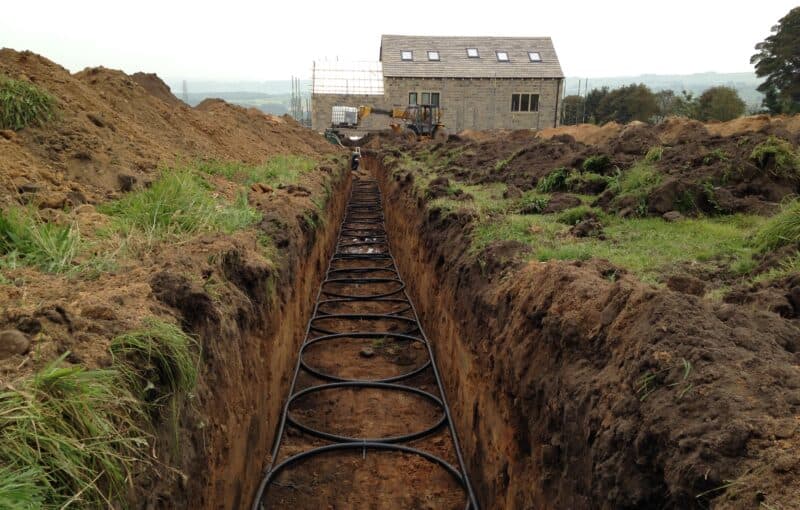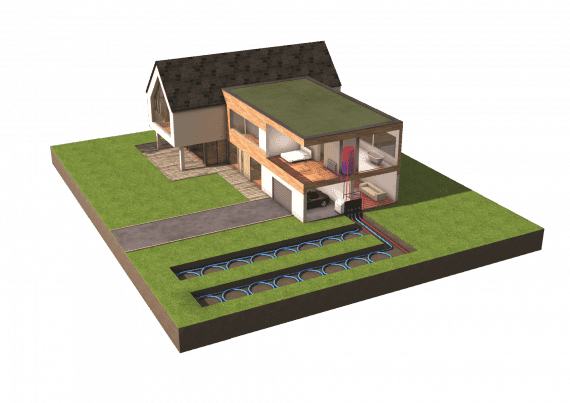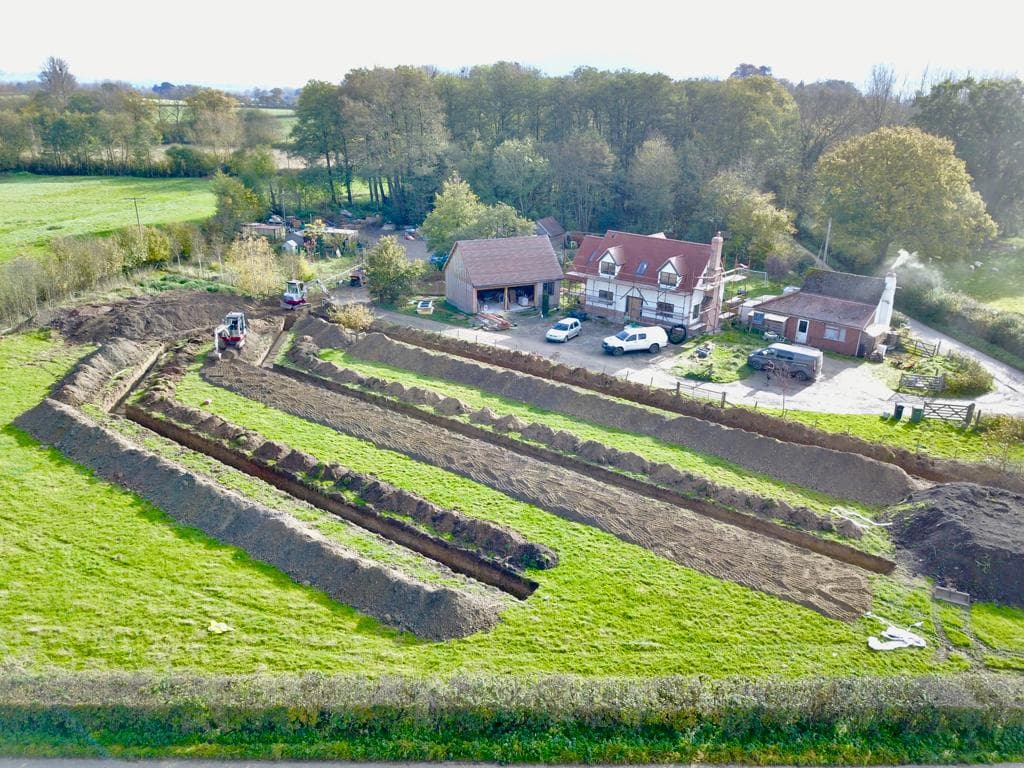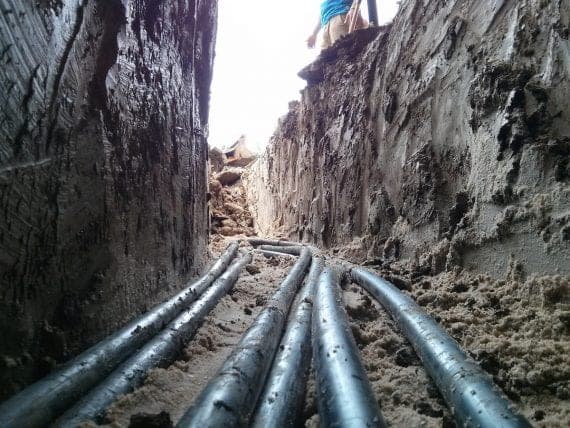What are Slinkies & Straight Pipes?

How do slinkies or straight pipes collect heat?
Slinkies or straight pipes collect heat from surface soil, about 1.2m below the ground. Maintaining a fairly constant temperature of 8-12°C all year round, the soil gains and replenishes most of its heat from solar energy.
Soil is a reliable source for heat pumps, and it was the first heat source used to work with ground source heat pumps – hence the name ‘ground source’. Nowadays many other sources can also be utilised by Kensa ground source heat pumps, such as water and rock.
See how a heat pump works

How much space do I need for them?
The length and number of slinky pipes required will depend on the heat demand of the property. Kensa manufactures three different lengths of slinky pipe: 30m, 40m and 50m long.
As a general guide, Kensa recommends 10m of trench with slinkies per kilowatt of the heat pump size. This means a 4kW heat pump will require one 40m long trench with slinky pipes buried in the ground for space heating. If domestic hot water is required, the length of the trench will increase slightly.
Slinkies vs. space-saving ground arrays
Also known as a horizontal ground array, a slinky trench takes up much more ground area than vertical arrays like boreholes, but it’s cheaper to install because there is no need for specialist drilling equipment.
Trenches are dug in the property’s surrounding space, such as the back garden.
Compare to other ground arrays

What if I don’t have the space to install them?
Surprisingly often, calculations for a ground array will show that the available garden area isn’t quite big enough to meet the heat load. One solution for this situation is to use boreholes, but this will typically add several thousands of pounds to the overall installation cost.
An alternative is spending some, or all, of this money on the building’s insulation to reduce the heat load. By reducing the heat load, the available garden area may well become viable as the heat source. It may even be possible to specify a smaller heat pump, further offsetting the insulation costs.
By adopting this solution, the energy bills will be significantly lower, the efficiency of the system will be higher and inevitably, its carbon footprint will be smaller.
Get Kensa’s full support
For your peace of mind, Kensa will help assess your ground array needs and provide detailed costs. To give us an idea of your project requirements, tell us about your plans for advice and a quote.
The slinkies or straight pipes are buried & backfilled
The pipework is connected to the heat pump to deliver heat energy
The ground array extracts heat for up to 100 years
What is the difference between slinky & straight pipe?
Slinky pipes
Slinkies are one of the world’s most popular ground collectors for heat pumps. They are Kensa’s favoured method of surface soil heat extraction.
A slinky is a length of coiled plastic pipe which is buried in the ground. The coiled pipe is usually installed horizontally and laid in long, narrow trenches.
Each slinky trench typically measures 1.2m wide by 1.2m deep. The trenches are spaced 5m apart to enable the natural replenishment of energy in the ground and avoid over-extraction of heat. This spacing also accommodates the excavated soil before the trenches are then backfilled.
Slinkies do not reduce the area of land required compared to using straight pipe. However, the benefit of slinkies is a significant reduction in the amount of digging required compared to using straight pipe – slinkies reduce the trench length by a factor of around 5, so are quicker and lower in cost to install.
Every 1m of a slinky trench contains around 5m of pipe, so slinkies make the most of the energy in every metre of dug ground. This is why Kensa manufactures a range of slinky pipes to complement our heat pump range and make ordering and installation even easier.
Slinky trenches for a Kensa ground source heat pump installation

Straight pipes
Straight pipes are laid in narrower trenches. Without the benefit of coils like the slinkies, straight pipes require more digging. To be precise, they require up to five times the length of digging compared to slinky pipes. Straight pipe trenches can be dug closer together than slinky trenches, but space for the spoil during excavation works will be limited.
There is no difference in the amount of ground required for slinkies or straight pipe. However, due to the additional trenching costs, straight pipe ground arrays are more expensive than slinky ground arrays.
Both straight pipe and slinky pipes utilise the same energy source, so their efficiency and performance are effectively identical.
Slinkies vs. straight pipe for heat pumps
Which is better, a slinky pipe or straight pipe? In reality, both are equally effective and easy to install if you have the correct excavation equipment. The amount of pipe and ground area you need is the same, as any ground array is sized appropriately to meet the building’s required heat load. For every 60m of pipe, approximately 1 kilowatt of energy can typically be absorbed from the ground.
Kensa supplies both types of ground array, but we usually recommend slinkies as they are more affordable and tend to have reduced installation costs.
Key things to remember when installing slinkies or straight pipes
The distance between trenches & property
Groundwork can flex around garden space
Ground obstacles can get in the way
Excess rainwater can be drained
Distance between manifold & slinkies can be adjusted
How to Unroll a Ground Source Heat Pump Slinky Pipe
Need help with your project?
Kensa has decades of experience when it comes to designing and installing ground arrays. For advice on your project, tell us about your plans.
Submit your plans for advice